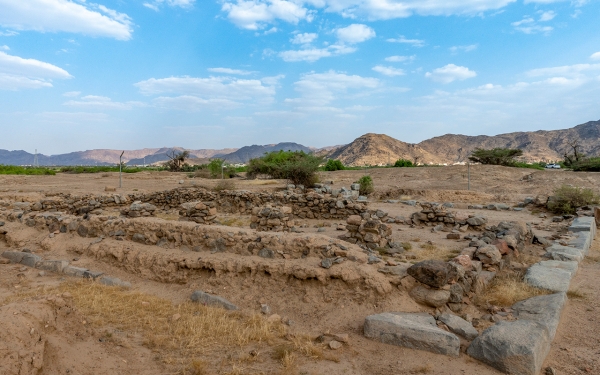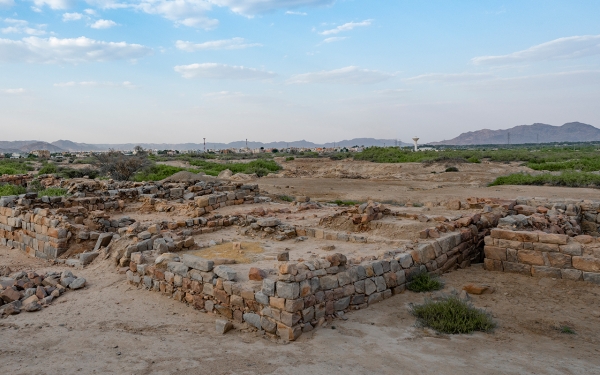


Al-Okhdood City, also known as Raqamat or Rijmat, is an archaeological city and tourist destination in the Najran Province, southwestern Saudi Arabia. It consists of a surrounding wall, remnants of buildings, artifacts, tombs, inscriptions, and drawings. Its oldest artifacts date back to the Stone Age, while its most recent ones belong to the Islamic period, including artifacts from the Umayyad and Abbasid eras.
Al-Okhdood City extends over an area of five km², situated on the southern bank of Wadi Najran, fourteen km south of the city of Najran, the Emirate of the region. It is adjacent to the Najran Regional Museum and is bordered to the north by Hama Wells, one of the sites of ancient rock art and inscriptions in the Kingdom.
The city was called al-Okhdood, which translates to "a ditch" or "a bottomless pit in the ground". It was named after the event mentioned in the Quran in Surat al-Burooj, which starts with the verse "Cursed were the people of the ditch". This event refers to Dhu Nuwas the Himyarite king, who threw believers of the Christian faith in a fire ditch after they refused to convert to Judaism.
Archaeological sites in al-Okhdood
Al-Okhdood City comprises around twenty-five buildings of carved stone and clay. Today, only the foundations and some walls remain, reaching a height of three to four m. Adjacent to these buildings is a large ancient millstone used for grinding grains. Al-Okhdood's most notable landmark is its citadel or fortress, which is believed to have been established from 500 BC. until mid-first century AD.
The city of al-Okhdood is enclosed by a wall that measures 235 meters in length and 220 meters in width. The rocks that make up its structures are adorned with animal drawings and rock inscriptions. In addition, human remains from the mid-first century AD were found within its walls.
Al-Okhdood was known as a central region where its inhabitants engaged in agriculture and trade. It served as a hub for the growth and expansion of the ancient city of Najran, and commercial caravans made it a station on the Incense Route. As a result, various kingdoms in south Arabia vied for control over the region at different points in history.
Excavations in al-Okhdood
Archaeological excavations in al-Okhdood City began in 1981, led by government authorities who collaborated with local and international research teams. As part of the Custodian of the Two Holy Mosques Cultural Heritage Program starting in 2013, al-Okhdood became one of the sites placed under the supervision of the Heritage Commission, previously known as the General Authority for Tourism and National Heritage. The program aimed to continue preserving and developing artifacts within more than fifteen archaeological and historical sites around Saudi Arabia.
Remarkable discoveries have been made during the ongoing excavations in the city, including remains such as pottery tools, animal figurines, coins, stones, inscribed stone and metal slabs, censers, and altars for animals.
In 2018, one of the excavation missions uncovered what became known as the "Najran Treasure." It consisted of a pottery jar containing over 2,850 silver coins that had been buried underground for approximately two millennia. The treasure also included metal seals and engraved stones written in the Musnad script. The coins depicted the images of Qataban and Himyarite kings who ruled from 300 BC to the mid-fifth century AD.
The musnad inscriptions in the al-Okhdood City
During the excavation works conducted by the Heritage Commission teams in 2023, several South Arabian musnad inscriptions were discovered at al-Okhdood site. One of the most noteworthy findings was a large inscription engraved on a granite stone, which consisted of a single line. It measured 230 cm in length and 48 cm in height, with letters that reached a length of 32 cm. This inscription is the longest musnad inscription ever found in the region. It belonged to a resident of al-Okhdood site named "Wahb Eel bin Ma'qan," who mentioned in his inscription that he worked on the irrigation of his house and possibly his palace.
Three gold rings with butterfly-shaped engravings on top were also discovered, all of which had the same shape and size. Additionally, a bronze bull head with traces of oxidation was found. The bull head was a prevalent symbol among the kingdoms of South Arabia during the pre-Islamic eras. It represented strength and fertility and was the most significant and prominent symbol among the Sabeans, the Minaeans, and the Qatabanians. In addition, various-sized pottery jars and an Attic ceramic vessel dating back to the third century BC were also found.
Related quizzes
Related articles
